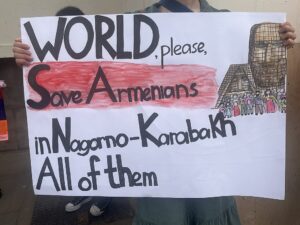According to reports, Armenia has received more than 100,000 refugees, as the mass exodus has emptied the enclave that has been under the ethnic Armenians’ control since 1991, which is when they declared it the Republic of Artsakh. Azerbaijan waited for 32 years to retain control over the territory. Although it got nothing but ghost towns on the ground, Baku has come out as a clear winner of the Karabakh conflict.
Yerevan, on the other hand, has suffered a major geopolitical defeat that could have far-reaching consequences for the very existence of the Republic of Armenia. Unable and unwilling to at least attempt to help Karabakh Armenians preserve control over the region, Yerevan has lost the last trump-card it could have used against Baku.
Defeated and humiliated, Armenia will undoubtedly have to make some very painful concessions to Azerbaijan. In the foreseeable future, the energy-rich South Caucasus nation will almost certainly pressure its Western neighbor to reach a deal regarding the delimitation and demarcation of the border. Yerevan will likely have to accept most, if not all, of Azerbaijan’s conditions, which means that it could soon lose control over some parts of the Republic of Armenia.
But that’s not the end of the Armenian tragedy. Now that the Karabakh conflict has been resolved in Azerbaijani favor, Baku is expected to insists on the construction of the Nakhchivan (or Zangezur) corridor through Armenian territory. The road and the railroad lines – leading from the western edge of mainland Azerbaijan, passing through the southern Armenian province of Syunik, and going to the eastern edge of Azerbaijani exclave of Nakhchivan – will create a new geopolitical reality in the South Caucasus.

Baku firmly insists that there must not be any Armenian presence on the Syunik section of the Nakhchivan corridor, not even passport or customs checks. Indeed, according to the Moscow-brokered ceasefire agreement that ended the 44-day war Armenia and Azerbaijan fought over Nagorno-Karabakh in 2020, Yerevan “guarantees the safety of transport links between the western regions of the Republic of Azerbaijan and the Nakhchivan Autonomous Republic”. More importantly, control over transport communication will be carried out not by the Armenian security forces, but by “the bodies of the Border Guard Service of the FSB of Russia”.
In other words, back in 2020, after Armenia lost the second Karabakh war, its Prime Minister Nikol Pashinyan agreed to allow Azerbaijan to establish a land link with Nakhchivan. Thus, Azerbaijani officials will demand that he implements the 2020 deal. As a result, Azerbaijan will be connected not only with its exclave of Nakhchivan, but also with its ally Turkey.
Ankara, for its part, has already started pressuring Armenia to close its Metsamor Nuclear Power Plant – located 16 kilometers from the city of Igdir in Eastern Turkey – a move that could result in Yerevan’s increased reliance on other countries for its energy needs. But since Armenia seeks to distance itself from its nominal ally Russia, it is not very probable that Moscow would back the landlocked nation of less than three million people in its dispute with Turkey – the Kremlin’s “strategic frenemy”.
Quite aware of that, Yerevan aims to establish close political and military ties with the West, hoping that such a strategy will help it strengthen its positions vis-à-vis Baku and Ankara. The problem for Armenia, however, is the fact that several Western countries seek to increase their energy cooperation with Azerbaijan, which is why Yerevan is unlikely to be able to count on their support.
At this point, the Islamic Republic of Iran remains the only foreign actor that seems to be genuinely interested in the preservation of Armeniа’s territorial integrity. Policy makers in Tehran know that the Nakhchivan corridor – if built under Azerbaijani conditions – would cut off Iran from Armenia. Moreover, the Islamic Republic would see its north semi-encircled by Turkic states. That is why its leaders have repeatedly stated that Armenia’s territorial integrity is Iran’s “red line”, and that Tehran “will not tolerate any changes to the regional borders”. However, it remains unclear how Iran will react if Pashinyan agrees to build the corridor through Armenia’s Syunik province, and allow Azerbaijan to have a direct link to NATO member Turkey.
One thing is for sure: the end of Nagorno-Karabakh will mark the beginning of a new era in the South Caucasus, where Russia and Iran will struggle to preserve their influence, while Azerbaijan, Turkey, and the West will come out as major winners who will by all means strengthen their positions in the strategically important region.
Image: Demonstration in London, September 2023 by Benoît Prieur and Exodus of ethnic Armenians from their homes in Nagorno-Karabakh (Artsakh) by Voice of America

